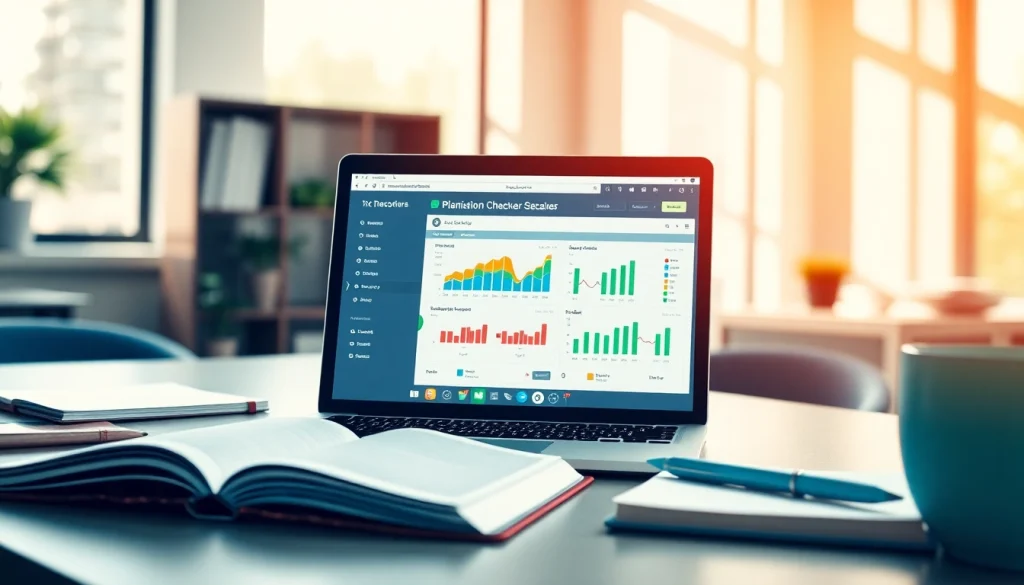
Understanding Plagiarism Checker Tools
What is a plagiarism checker?
A plagiarism checker is a digital tool designed to detect instances of plagiarism within a body of text. Typically utilized by students, educators, and content writers, these tools analyze the submitted material against an extensive database of sources, including academic journals, websites, and other published works. The primary purpose of a plagiarism checker is to ensure originality in writing, support academic integrity, and uphold ethical standards in content creation. By identifying copied text or unoriginal ideas, users can take corrective actions to restructure or properly cite their work, thereby enhancing its authenticity.
How plagiarism checker works
The operational framework of a plagiarism checker incorporates several advanced techniques, including text-matching algorithms, citation detection, and semantic analysis. Upon submission of a document, the tool parses the text into smaller segments. Plagiarism checker systems typically follow these steps:
- Text Segmentation: The identified text is broken into phrases, sentences, or keywords.
- Database Comparison: Each segment is compared to a vast database, which may include academic publications, online articles, and student papers.
- Similarity Scoring: The checker assigns a ‘similarity score’ based on the percentage of matched content found.
- Report Generation: Once the analysis is complete, a report is generated detailing matched texts, their sources, and recommendations for citation or revision.
This systematic approach allows users to pinpoint specific areas of concern in their writing, ensuring that all present content is both legitimate and ethically sourced.
Types of plagiarism checkers available
There are several varieties of plagiarism checkers tailored to different needs:
- Basic Online Checkers: Free tools that offer a limited assessment of text for plagiarism, suitable for casual use.
- Academic Checkers: Advanced tools designed for educational institutions, capable of integrating with Learning Management Systems (LMS) to detect and prevent academic dishonesty.
- Content Management Systems: Integrated plagiarism checking tools within content creation platforms, allowing writers to assess originality during the drafting process.
- Enterprise Solutions: Customized enterprise-level plagiarism detection services for large organizations that require comprehensive content checks across multiple sources.
Benefits of Using a Plagiarism Checker
Enhancing academic integrity with plagiarism checker
The importance of academic integrity cannot be overstated in educational environments. Utilizing a plagiarism checker encourages responsible writing practices. By actively checking their work for potential plagiarism before submission, students can foster a culture of honesty and accountability. Moreover, educational institutions often mandate the use of these tools to maintain rigorous academic standards, deterring dishonest practices and supporting students in developing their own voice.
Improving content originality
For content marketers, writers, and creatives, originality is a crucial aspect of impactful communication. A plagiarism checker plays a vital role in helping creators ensure that their work is unique. By identifying similarities with existing content, writers can rephrase, cite correctly, or inject their own insights into the text, resulting in richer, more engaging material that stands out in an overly saturated market.
Saving time and effort in research
In the fast-paced world of academic and professional writing, time is of the essence. A plagiarism checker can streamline the revision process, providing authors with instant feedback on potential issues related to originality. By quickly identifying plagiarized sections, writers can focus on content development and enhancement, drastically reducing the time spent on revising after submission or publication.
How to Choose the Right Plagiarism Checker
Key features to consider in plagiarism checker
Choosing the right plagiarism checker can significantly impact the quality of your writing process. Here are several critical features to consider:
- Database Size: A robust database ensures comprehensive checking against a wide array of sources. The more extensive the database, the higher the likelihood of detecting potential issues.
- Accuracy of Results: Invest in tools with proven algorithms that provide reliable and accurate results to minimize false positives.
- User Interface: An intuitive interface enhances user experience and allows for seamless navigation through reports.
- Real-time Checking: Tools that integrate real-time checking within writing experiences help authors identify issues as they write, streamlining the process.
- Support for Multiple Formats: The capability to check a variety of file types (e.g., PDF, DOCX, plaintext) is essential for diverse writing projects.
Comparing free vs. paid plagiarism checker
When deciding between free and paid options, there are numerous factors that writers should evaluate. Free plagiarism checkers typically offer basic functionality and limited database access, sufficient for casual use but often inadequate for academic or professional requirements. On the other hand, paid services offer advanced features, including comprehensive databases, faster processing, and detailed reporting. Ultimately, the choice hinges on the user’s specific needs and the level of assurance required in their writing.
User reviews and recommendations
Researching user reviews and recommendations can provide valuable insight into the effectiveness of different plagiarism checkers. Look for feedback regarding accuracy, ease-of-use, customer support, and overall user satisfaction. Many platforms allow users to share their experiences, helping potential users to make informed decisions based on the collective opinions of their peers.
Common Challenges When Using a Plagiarism Checker
Understanding false positives
One common challenge faced by users is encountering false positives. A false positive occurs when the software identifies original content as plagiarized. This can result from the use of common phrases or clichéd expressions. Understanding the limitations of plagiarism checkers and recognizing that not all flagged content is problematic is crucial. Users should examine the highlighted areas carefully and make decisions based on their understanding of the context.
Limitations of different plagiarism checkers
Each plagiarism checker features distinctive strengths and weaknesses. Some may excel in academic contexts, while others cater more to content marketing needs. It’s also important to remember that no tool can detect all forms of plagiarism—such as self-plagiarism or paraphrasing without proper attribution. Users should supplement their findings with their judgment and additional resources.
Addressing concerns over data privacy
Another critical issue in using online plagiarism checkers involves data privacy. Users often worry about sensitive information being stored or shared inadvertently. It is essential to choose a reputable plagiarism checker that emphasizes data security and has a clear privacy policy outlining how user data will be treated. Familiarize yourself with the terms and conditions, ensuring that your work remains confidential, especially if it is related to sensitive academic or professional endeavors.
Best Practices for Using a Plagiarism Checker Effectively
Integrating plagiarism checker into your writing process
Utilizing a plagiarism checker should be an integral part of your writing process rather than a last-minute check. By incorporating it early in the drafting phase, you can identify issues sooner and create a more authentic piece of work. Make it a habit to review your text with a plagiarism checker before finalizing your drafts, providing you with ample time for corrections and revisions.
Analyzing reports generated by the plagiarism checker
Understanding the reports generated by a plagiarism checker is essential for extracting maximum value from the tool. Learn how to interpret the similarity scores, identify the types of matches (exact vs. paraphrased), and recognize the sources cited. This analysis will empower you to take appropriate action—be it revising content, proper citation, or restructuring ideas to enhance originality.
Tips for revising content based on checker feedback
When revising content based on the feedback from a plagiarism checker, consider the following tips:
- Paraphrase: Rewrite flagged sections in your own words while retaining the original meaning. This practice enhances originality and demonstrates critical understanding.
- Use Citations: If the content is integral to your argument or narrative, be sure to provide proper citations. This approach shows respect for the original authors and adds credibility to your work.
- Adopt a Unique Voice: Infuse your personality and style into your writing. By establishing a unique voice, you can diminish the likelihood of unintentional plagiarism.
- Seek Feedback: Collaborate with peers or mentors who can provide constructive feedback on your content, particularly in areas flagged by the checker.






